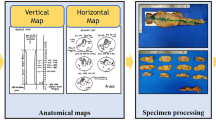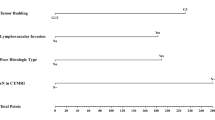Abstract
Purpose
The aim of this study was to develop and validate a nomogram model to evaluate lymph node metastasis (LNM) in patients with rectal cancer (RC).
Methods
A total of 162 patients with RC were included in the study. The MRI reported model, the Radscore model, and the Complex model were constructed using the logistics regression (LR) algorithm. The DeLong test and decision curve analysis (DCA) were used to compare the prediction performance and clinical utility of these models. The nomogram model was constructed to visualize the prediction results of the best model. Model performance was evaluated in the training and validation groups, and the calibration curve and Hosmer–Lemeshow goodness of fit test were used to evaluate the calibration.
Result
All three models constructed by the LR algorithm were good at identifying LNM. The DeLong test and the DCA results showed that the Complex model outperformed the MRI reported model and the Radscore model in relation to their predictive performance and clinical utility. The nomogram of the Complex model had an area under the curve (AUC) of 0.902 (95% confidence interval (CI) 0.848–0.957) in the training group and an AUC of 0.891 (95% CI 0.799–0.983) in the validation group. Meanwhile, the nomogram showed good calibration.
Conclusion
The nomogram model constructed based on T2WI radiomics and MRI reported had good diagnostic efficacies for LNM in patients with RC, and provided a new auxiliary method for accurate and individualized clinical management.
Graphical abstract







Similar content being viewed by others

References
Sung H, Ferlay J, Siegel RL, Laversanne M, Soerjomataram I, et al. Global Cancer Statistics 2020: GLOBOCAN Estimates of Incidence and Mortality Worldwide for 36 Cancers in 185 Countries. CA Cancer J Clin. 2021 May;71(3):209-249. https://doi.org/10.3322/caac.21660.
Chang SH, Patel N, Du M, Liang PS. Trends in Early-onset vs Late-onset Colorectal Cancer Incidence by Race/Ethnicity in the United States Cancer Statistics Database. Clin Gastroenterol Hepatol. 2022 Jun;20(6):e1365-e1377. https://doi.org/10.1016/j.cgh.2021.07.035.
Chen W, Zheng R, Baade PD, Zhang S, Zeng H, et al. Cancer statistics in China, 2015. CA Cancer J Clin. 2016 Mar-Apr;66(2):115-32. https://doi.org/10.3322/caac.21338
Peyravian N, Larki P, Gharib E, Nazemalhosseini-Mojarad E, Anaraki F, et al. The Application of Gene Expression Profiling in Predictions of Occult Lymph Node Metastasis in Colorectal Cancer Patients. Biomedicines. 2018 Mar 2;6(1):27. https://doi.org/10.3390/biomedicines6010027.
Arnold M, Sierra MS, Laversanne M, Soerjomataram I, Jemal A, et al. Global patterns and trends in colorectal cancer incidence and mortality. Gut. 2017 Apr;66(4):683-691. https://doi.org/10.1136/gutjnl-2015-310912.
Beets-Tan RG, Beets GL. MRI for assessing and predicting response to neoadjuvant treatment in rectal cancer. Nat Rev Gastroenterol Hepatol. 2014 Aug;11(8):480-8. https://doi.org/10.1038/nrgastro.2014.41.
Yang Z, Liu Z. The efficacy of 18F-FDG PET/CT-based diagnostic model in the diagnosis of colorectal cancer regional lymph node metastasis. Saudi J Biol Sci. 2020 Mar; 27(3):805-811. https://doi.org/10.1016/j.sjbs.2019.12.017.
Ma X, Shen F, Jia Y, Xia Y, Li Q, et al. MRI-based radiomics of rectal cancer: preoperative assessment of the pathological features. BMC Med Imaging. 2019 Nov 12;19(1):86. https://doi.org/10.1186/s12880-019-0392-7.
Li M, Zhang J, Dan Y, Yao Y, Dai W, et al. A clinical-radiomics nomogram for the preoperative prediction of lymph node metastasis in colorectal cancer. J Transl Med. 2020 Jan 30;18(1):46. https://doi.org/10.1186/s12967-020-02215-0.
Noura S, Yamamoto H, Ohnishi T, Masuda N, Matsumoto T, et al. Comparative detection of lymph node micrometastases of stage II colorectal cancer by reverse transcriptase polymerase chain reaction and immunohistochemistry. J Clin Oncol. 2002 Oct 15;20(20):4232-41. https://doi.org/10.1200/JCO.2002.10.023.
Ishihara S, Kawai K, Tanaka T, Kiyomatsu T, Hata K, et al. Oncological Outcomes of Lateral Pelvic Lymph Node Metastasis in Rectal Cancer Treated With Preoperative Chemoradiotherapy. Dis Colon Rectum. 2017 May;60(5):469-476. https://doi.org/10.1097/DCR.0000000000000752.
Glynne-Jones R, Wyrwicz L, Tiret E, Brown G, Rödel C, et al. ESMO Guidelines Committee. Rectal cancer: ESMO Clinical Practice Guidelines for diagnosis, treatment and follow-up. Ann Oncol. 2017 Jul 1;28(suppl_4):iv22-iv40. https://doi.org/10.1093/annonc/mdx224.
Liu Y, Wan L, Peng W, Zou S, Zheng Z, et al. A magnetic resonance imaging (MRI)-based nomogram for predicting lymph node metastasis in rectal cancer: a node-for-node comparative study of MRI and histopathology. Quant Imaging Med Surg. 2021 Jun;11(6):2586-2597. https://doi.org/10.21037/qims-20-1049.
Seber T, Caglar E, Uylar T, Karaman N, Aktas E, et al. Diagnostic value of diffusion-weighted magnetic resonance imaging: differentiation of benign and malignant lymph nodes in different regions of the body. Clin Imaging. 2015 Sep-Oct;39(5):856-62. https://doi.org/10.1016/j.clinimag.2015.05.006.
Oberholzer K, Menig M, Pohlmann A, Junginger T, Heintz A, et al. Rectal cancer: assessment of response to neoadjuvant chemoradiation by dynamic contrast-enhanced MRI. J Magn Reson Imaging. 2013 Jul;38(1):119-26. https://doi.org/10.1002/jmri.23952.
Kim MJ, Lee SJ, Lee JH, Kim SH, Chun HK, et al. Detection of rectal cancer and response to concurrent chemoradiotherapy by proton magnetic resonance spectroscopy. Magn Reson Imaging. 2012 Jul;30(6):848-53. https://doi.org/10.1016/j.mri.2012.02.013.
Atkin G, Taylor NJ, Daley FM, Stirling JJ, Richman P, et al. Dynamic contrast-enhanced magnetic resonance imaging is a poor measure of rectal cancer angiogenesis. Br J Surg. 2006 Aug;93(8):992-1000. https://doi.org/10.1002/bjs.5352.
Huang YQ, Liang CH, He L, Tian J, Liang CS, et al. Development and Validation of a Radiomics Nomogram for Preoperative Prediction of Lymph Node Metastasis in Colorectal Cancer. J Clin Oncol. 2016 Jun 20;34(18):2157-64. https://doi.org/10.1200/JCO.2015.65.9128.
Horvat N, Bates DDB, Petkovska I. Novel imaging techniques of rectal cancer: what do radiomics and radiogenomics have to offer? A literature review. Abdom Radiol (NY). 2019 Nov;44(11):3764-3774. https://doi.org/10.1007/s00261-019-02042-y.
Lambin P, Leijenaar RTH, Deist TM, Peerlings J, de Jong EEC, et al. Radiomics: the bridge between medical imaging and personalized medicine. Nat Rev Clin Oncol. 2017 Dec;14(12):749-762. https://doi.org/10.1038/nrclinonc.
Zwanenburg A, Vallières M, Abdalah MA, Aerts HJWL, Andrearczyk V, et al. The Image Biomarker Standardization Initiative: Standardized Quantitative Radiomics for High-Throughput Image-based Phenotyping. Radiology. 2020 May;295(2):328-338. https://doi.org/10.1148/radiol.2020191145.
Meng X, Xia W, Xie P, Zhang R, Li W, et al. Preoperative radiomic signature based on multiparametric magnetic resonance imaging for noninvasive evaluation of biological characteristics in rectal cancer. Eur Radiol. 2019 Jun;29(6):3200-3209. https://doi.org/10.1007/s00330-018-5763-x.
Zhao H, Su Y, Wang M, Lyu Z, Xu P, et al. The Machine Learning Model for Distinguishing Pathological Subtypes of Non-Small Cell Lung Cancer. Front Oncol. 2022 May 26;12:875761. https://doi.org/10.3389/fonc.2022.875761.
Ying M, Pan J, Lu G, Zhou S, Fu J, et al. Development and validation of a radiomics-based nomogram for the preoperative prediction of microsatellite instability in colorectal cancer. BMC Cancer. 2022 May 9;22(1):524. https://doi.org/10.1186/s12885-022-09584-3.
Sun Y, Li C, Jin L, Gao P, Zhao W, et al. Radiomics for lung adenocarcinoma manifesting as pure ground-glass nodules: invasive prediction. Eur Radiol. 2020 Jul;30(7):3650-3659. https://doi.org/10.1007/s00330-020-06776-y.
Li F, Hu J, Jiang H, Sun Y. Diagnosis of lymph node metastasis on rectal cancer by PET-CT computer imaging combined with MRI technology. J Infect Public Health. 2020 Sep;13(9):1347-1353. https://doi.org/10.1016/j.jiph.2019.06.026.
Pages F, Mlecnik B, Marliot F, et al. International validation of the consensus Immunoscore for the classification of colon cancer: a prognostic and accuracy study. Lancet. 2018 May 26;391(10135):2128-2139. https://doi.org/10.1016/S0140-6736(18)30789-X.
Liu L, Liu Y, Xu L, Li Z, Lv H, et al. Application of texture analysis based on apparent diffusion coefficient maps in discriminating different stages of rectal cancer. J Magn Reson Imaging. 2017 Jun;45(6):1798-1808. https://doi.org/10.1002/jmri.25460.
Wang D, Zhuang Z, Wu S, Chen J, Fan X, et al. A Dual-Energy CT Radiomics of the Regional Largest Short-Axis Lymph Node Can Improve the Prediction of Lymph Node Metastasis in Patients With Rectal Cancer. Front Oncol. 2022 Jun 7;12:846840. https://doi.org/10.3389/fonc.2022.846840.
Heijnen LA, Lambregts DM, Mondal D, Martens MH, Riedl RG, et al. Diffusion-weighted MR imaging in primary rectal cancer staging demonstrates but does not characterise lymph nodes. Eur Radiol. 2013 Dec;23(12):3354-60. https://doi.org/10.1007/s00330-013-2952-5.
Yang YS, Feng F, Qiu YJ, Zheng GH, Ge YQ, et al. High-resolution MRI-based radiomics analysis to predict lymph node metastasis and tumor deposits respectively in rectal cancer. Abdom Radiol (NY). 2021 Mar;46(3):873-884. https://doi.org/10.1007/s00261-020-02733-x.
Vickers AJ. Prediction models: revolutionary in principle, but do they do more good than harm? J Clin Oncol. 2011 Aug 1;29(22):2951-2. https://doi.org/10.1200/JCO.2011.36.1329.
Funding
The authors did not receive support from any organization for the submitted work.
Author information
Authors and Affiliations
Contributions
All authors contributed to the study conception and design. YS and HZ provided the overall design of the experiments and contributed equally to the experiments. Material preparation, data collection and analysis were performed by LZ, YJ, PX, and ZL. The first draft of the manuscript was written by YS and HZ, and all authors commented on previous versions of the manuscript. PF and PL supervised the study. All authors read and approved the final manuscript.
Corresponding author
Ethics declarations
Conflict of interest
The authors have no competing interests to declare that are relevant to the content of this article.
Ethical approval
This retrospective chart review study involving human participants was in accordance with the ethical standards of the institutional and national research committee and with the 1964 Helsinki Declaration and its later amendments or comparable ethical standards. The study was approved by the First Affiliated Hospital of Harbin Medical University (No. 2021JS44). Due to the retrospective and non-interventional nature of the study, the written informed consent was waived by The First Affiliated Hospital of Harbin Medical University Review Board.
Additional information
Publisher's Note
Springer Nature remains neutral with regard to jurisdictional claims in published maps and institutional affiliations.
The paper has been preprinted at the Research Square. The specific information and link are followed: Yexin Su, Hongyue Zhao, Linhan Zhang et al. A Nomogram Model Developed and Validated for The Evaluation of Lymph Node Metastasis in Patients with Rectal Cancer, 14 February 2022, PREPRINT (Version 1) available at Research Square [https://doi.org/10.21203/rs.3.rs-1297512/v1].
Rights and permissions
Springer Nature or its licensor holds exclusive rights to this article under a publishing agreement with the author(s) or other rightsholder(s); author self-archiving of the accepted manuscript version of this article is solely governed by the terms of such publishing agreement and applicable law.
About this article
Cite this article
Su, Y., Zhao, H., Liu, P. et al. A nomogram model based on MRI and radiomic features developed and validated for the evaluation of lymph node metastasis in patients with rectal cancer. Abdom Radiol 47, 4103–4114 (2022). https://doi.org/10.1007/s00261-022-03672-5
Received:
Revised:
Accepted:
Published:
Issue Date:
DOI: https://doi.org/10.1007/s00261-022-03672-5



